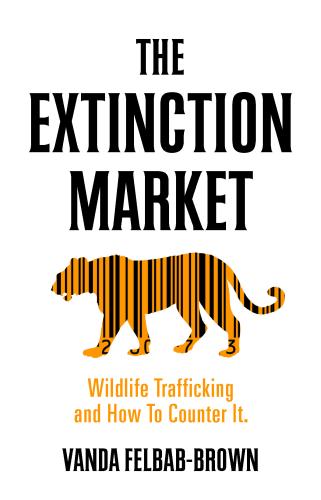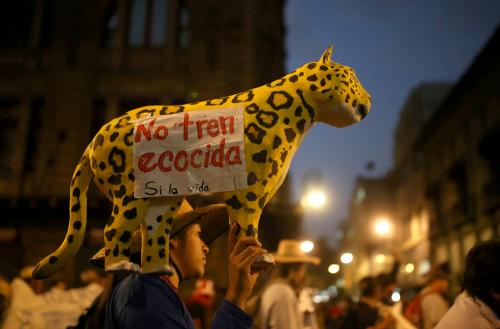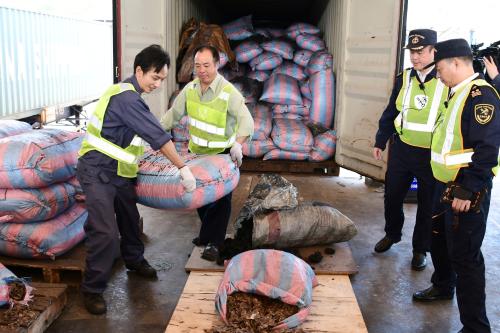The following is an excerpt from Reopening the World: How to Save Lives and Livelihoods, a new report where Brookings experts offer ideas to help policymakers protect lives and save livelihoods in the midst of the current COVID-19 pandemic.
 The global public health and economic devastation caused by the coronavirus outbreak dramatically reinforces the urgent imperative to minimize the chances of another zoogenic pandemic. Reducing the likelihood of another viral spillover sweeping the world requires minimizing human interface with wild animals and wild spaces; eliminating transmission points where the likelihood of viral spillover to humans is high, such as unhygienic commercial markets in wild animal meat and live animals; diligently suppressing illegal and unsustainable trade in wildlife; and conserving natural habitats. Conserving natural habitats in turn requires profound changes in human food production and human encroachment on remaining natural habitats.
The global public health and economic devastation caused by the coronavirus outbreak dramatically reinforces the urgent imperative to minimize the chances of another zoogenic pandemic. Reducing the likelihood of another viral spillover sweeping the world requires minimizing human interface with wild animals and wild spaces; eliminating transmission points where the likelihood of viral spillover to humans is high, such as unhygienic commercial markets in wild animal meat and live animals; diligently suppressing illegal and unsustainable trade in wildlife; and conserving natural habitats. Conserving natural habitats in turn requires profound changes in human food production and human encroachment on remaining natural habitats.
However, the necessary measures to prevent another pandemic should not entail banning all trade in wildlife. Such a policy would be deeply counterproductive since it would eliminate economic incentives for preserving critical natural ecosystems. Nor should the measures involve eliminating livelihoods of the hundreds of millions of people dependent on hunting for basic food security and subsistence.
In order to preserve habitats and wildlife and keep them away from humans to minimize a zoogenic viral spillover to humans, global demand for some wildlife products, not just wild meat, but also aspects of Traditional Chinese Medicine (TCM), also needs to be reduced.
Adopting such smart, tailored, and essential pandemic prevention measures is crucial for maximum policy effectiveness. Unless the necessary policy approaches are adopted, another pandemic will emerge with similar or even more severe consequences. Policies based principally on defensive reactive responses, such as strengthening health care systems or reshaping global production and logistical chains, will be overwhelmed.
KEY CAUSES AND TRANSMISSION LOCALES
The COVID-19 pandemic exploded in a so-called wet market in Wuhan, China, and entailed the meat of wild animals. In 2003, China experienced the emergence of another epidemic, the Severe Acute Respiratory Syndrome (SARS), once again containing meat from wild animals. Across East and Southeast Asia, open-air markets with wild animals often illegally caught and kept in appalling and dangerously unhygienic conditions, and markets selling wild animal meat without proper hygienic measures in place, pose high risks of severe zoogenic pandemics.
But such pandemics can also emerge elsewhere as a result of improper husbandry of domestic or wild animals that fails to separate wild animals from domestic livestock, or from veterinary failures. Such regulatory deficiencies are pervasive around the world and persist also in the United States. The H1N1 swine flu that killed 10,000 Americans emerged in North America as a result of packing thousands of domestic livestock together in a cramped space for food production.
Human encroachment on natural habitat, in the tropics in particular, poses another severe threat of zoogenic disease emergence. With more habitat lost and fragmented due to deforestation, more animals crowd together in small places where the chance of a viral spillover among species significantly increases. When humans and their domesticated animals enter such shrunk places for logging, mining, hunting, road construction, or building of residences, the chance that the new zoogenic disease jumps to humans goes severely up.
In response to COVID-19, Vietnam—a large source, transshipment, and destination country for both legal and massive illegal trade in wildlife—has banned its live wild animal markets. China has declared a ban on consumption of wild meat in an updated law on “Comprehensively Prohibiting the Illegal Trade of Wild Animals, Eliminating the Bad Habits of Wild Animal Consumption, and Protecting the Health and Safety of the People,” and appears to be shutting down some wildlife markets and wildlife farms, while other persist. In China, wildlife farming involves 20,000 facilities and is worth $57 billion annually. While wildlife farming has been crucial for alleviating poverty in China, improperly maintained farms are prime areas of zoogenic disease emergence.
Such farms exist around the world. Not all should be shut down—as long as they are not in fact stocked with animals poached from the wild, preserve natural habitats, and do not set off an unsustainable demand for the same species caught in the wild. U.S. farming of alligators is a prime example of major conservation and economic success. But the hygienic and veterinary practices of wildlife farms around the world need to be radically improved.
And all legal trade in wildlife—a massive global business involving millions of live specimens of wild animals annually—needs to be systematically monitored to prevent disease spread to native animal species, domestic livestock, and humans. Dangerously, the overwhelming majority of the global legal trade in wildlife is not subject to any disease monitoring. This critical regulatory gap posing an enormous risk of zoogenic disease emergence also exists in the United States where most imports of wild animals do not require a health certificate nor are tested for disease.
China’s and Vietnam’s actions are very important steps, but their value will be diminished if their enforcement weakens as the memory of the COVID-19 devastation wanes and a vaccine becomes available. Such dangerous weakening of law enforcement, in fact, happened within three years of China’s prohibition of wildlife markets in the wake of SARS. Bans without persistent enforcement are completely ineffective. Dangerously, enforcement of national policies is left with Chinese municipal and provincial authorities who mostly prioritize economic interests such as employment and revenue generation over public health and are highly susceptible to capture by vested economic interests.
THE RISKS OF REGULATORY OVERREACH
A ban on commercial markets in wild meat is imperative, but such an approach on all wildlife trade would undermine conservation and increase the chance of another pandemic. A lot of wildlife products in various animal parts, such as skins and furs, are traded for souvenirs and curios, clothing, and many other uses. Such trade does not pose a risk of a pandemic. If the offtake from the wild is well-regulated to preserve sustainability and is devoid of corruption—no doubt, often a challenge—it critically augments conservation. It gives landowners and local communities a powerful economic stake in preserving natural habitats and wildlife and allowing converted landscapes to revert to their more natural state, thus resurrecting ecosystems.
In the absence of economic value of biodiversity preservation, both governmental and private landowners starved of revenues will be susceptible to powerful economic pressure to deforest land for timber and agricultural production—and thus augmenting chances of zoogenic disease emergence. Without economic revenue from natural spaces and wild animals, the economic pressure from powerful vested interests promoting logging for timber and land, mining, cattle ranching, agricultural production and deforestation—including for African oil palm—and poaching for the illegal wildlife trade may become irresistible to governments, businesses, and local communities starved of money due to COVID-19 and facing recessions, bankruptcies, and lack of livelihoods.
COVID-19 is causing a critical drying up of vital ecotourism funding for local communities, rangers, landowners, and protected area administration. Poaching is increasing and will continue to rise as ecotourism remains diminished easily deep into 2021. Pressures to convert land will also rise. Elsewhere, ecotourism never brought sustained and sufficient funding to make biodiversity preservation viable. Thus, it is crucial to diversify funding beyond ecotourism, whether by pricing biodiversity and creating private markets in habitat conservation or augmenting financial transfers from developed to developing countries for habitat preservation—in essence, with government, industries, and businesses buying themselves pandemic prevention by preserving habitat.
The important and necessary bans on commercial wild meat markets need to avoid two kinds of regulatory overreach. First, hundreds of millions of people around the world depend on hunting for protein access. A ban on wild meat should not undermine their food security, and local subsistence markets should be exempted. However, increased efforts are needed to generate alternative sources of protein for them, such as from poultry, even when it requires changing a preference in taste, by explaining the risks of wild meat consumption. Where alternative protein livelihood efforts are not feasible, testing kits need to be available to local communities to test for dangerous pathogens in meat (and even fruit), such as those that cause outbreaks of Ebola and other dangerous pathogens.
Second, consumption of wild meat may enhance conservation by improving habitat quality (a result of consumption of overpopulated deer in the United States or of wild boar in Europe); or the preservation of quality habitats (such a result of the consumption of particular antelope species in Africa); or by enabling restoration of a species in the wild (such as a result of bison husbandry in the United States). In such cases governments can allow exceptions from bans on wild meat. The exceptions can be given if the species is not endangered or threatened or carries high risk of pathogen transmission; and its slaughtering is conducted according to strict hygienic rules that minimize the chance of zoogenic disease emergence. Hunting for personal subsistence should not be affected in forest-dependent communities or developed countries, though the meat should be tested for pathogens.
Wet markets in China and Asia should not be banned because most do not sell meat from terrestrial wild animals where zoogenic disease can emerge. Indeed, they provide access to food for large numbers of people in Asia and around the world, sometimes as much as 30–40 percent of the population. However, diligent monitoring and enforcement need to be implemented, such as through the use of CCTV cameras, as these markets do not in fact sell meat from wild terrestrial animals, as happened in Wuhan 67 Wet markets should not be conflated with the dangerous bird and wildlife markets in Asia and elsewhere in the world where thousands of species of many families are crammed together in tiny spaces, often with hundreds of specimens in the same cage, including dead animals rotting unremoved from the cage, and with inadequate food, water, and protection from weather. Such markets should be banned and the ban diligently enforced even though it will affect the livelihoods of traders. Poor traders may have to be compensated for their losses. To the extent that governments give permission to sell animals in stores, the licensing and inspection processes need to ensure that proper care and hygienic conditions are maintained to minimize the likelihood of zoogenic disease emergence.
A diligent effort needs to be mounted to enforce such bans, anticipating that it will push trade in wild animals and meat underground or online. Monitoring and shutting down such clandestine markets pose challenges, but law enforcement forces can overcome them with undercover operators posing as fake buyers. But any time barriers to entry are put up for a market, demand goes down—as some buyers will not invest in seeking out hidden private online platforms or locating an underground market. The less demand, the fewer customers, the smaller chance of a disease jumping to humans. It is imperative to achieve sufficient and substantial prevalence of effective identification and prosecution of violators to create deterrence effects against clandestine offenses. Such a robust prosecution rate in turn requires resources for adequate wildlife enforcement and the monitoring of legal wildlife and food markets.
THE RISKS OF REGULATORY UNDERREACH
There are also multiple risks of regulatory underreach. If the ban on commercial markets selling meat from wild animals or on unhygienic wildlife markets remains confined only to China and Vietnam, the chances of zoogenic disease emergence will remain high in other Southeast Asian countries with extensive unhygienic wildlife markets and high risks of pathogen transmission— namely Indonesia, Laos, and Myanmar. If these persist and demand in China and elsewhere in Southeast Asia is not dramatically reduced, consumers of wild meat and end-use buyers of wild animals will merely outsource the risk of pathogen transmission to developing countries unprepared for dealing with a zoogenic pandemic. Chinese traders could simply arrange the poaching of pangolins in Africa—not just for scales but for their meat—and have it frozen. The viral spillover then occurs among poor hunters abroad while Asian traders and consumers do not necessarily see their profits and habits affected.
Such markets are also growing in Peru, Brazil, and elsewhere in Latin America as well as among the affluent in Africa, increasingly involving domestic tourists buying luxury wild meat or animal parts, or Chinese and Asian traders facilitating wildlife trade and trafficking abroad. This growing demand for such products needs to be stamped out. The more it grows, the more difficult it will be to mount effective demand reduction and supply suppression measures. It is imperative to suppress the illegal hunting, sale, and transportation of animals and animal parts in Latin America and around the world by shutting down markets selling animals illegally, and focusing on the apprehension of the crucial operational middle–layer of trafficking networks, and enhancing in situ law enforcement.
In addition, severe risks to human health are often the best motivators of environmental policies—viz. regulations emerging in response to severe health effects of acid rain or ozone depletion. COVID-19 provides a tragic but important opportunity to reduce global demand for the consumptive use of animals which has been producing unsustainable exploitation and extinction. Global efforts are needed to reduce such dangerous and increasing demand by emphasizing the risks of dangerous wildlife products. Beyond reducing demand for wild meat, it is imperative to suppress demand 68 and supply of those aspects of so-called TCM that produce such unsustainable offtake and poaching, which has been driving to extinction tigers, rhinoceros, hornbills, and a vast scope of other endangered or threatened animals and plants.
Whether and how fast another zoogenic pandemic emerges will be determined not only by sound regulations and their diligent enforcement…but also, crucially, by continuing reminders to the world’s publics of why those regulations are necessary.
Effectively regulating and curbing the excesses and dangers of the TCM industry will be challenging, as the TCM industry in China is politically powerful. It provides large economic revenues to China’s government and employment to many people. It will resist any regulation. During and after the SARS epidemic, it pushed TCM as a cure. Since then, it orchestrated the imprisonment of Chinese doctors who warned against the many TCM health risks. For years, the government of China has strongly embraced the TCM industry and worked to advance its interests abroad. In 2019, China succeeded in cajoling the World Health Organization into including a chapter on TCM in its International Classification of Diseases, a highly influential document that categorizes and assigns codes to medical conditions, and is used internationally to decide how doctors diagnose conditions and whether insurance companies will pay to treat them. The Chinese government is already promoting—without any proof—the use of TCM to cure COVID-19 and is encouraging the export of such unproven COVID-19 TCM cures to highly vulnerable countries with critically inadequate health systems such as Afghanistan and Pakistan.
Adopting and maintaining crucial changes will not be easy. Banning dangerous wildlife markets and commercial markets in wild meat is a first step. But as memory of COVID-19 wanes and a vaccine becomes available, enforcement will weaken. Dangerous habits in eating wild meat or keeping wild animals as pets will rise again. Vested interests such as logging, mining, agricultural, and TCM industries will push back against needed regulation and its enforcement. Whether and how fast another zoogenic pandemic emerges will be determined not only by sound regulations and their diligent enforcement that avoid both policy underreach and overreach, but also, crucially, by continuing reminders to the world’s publics of why those regulations are necessary. The United States must be at the forefront of such global efforts, leading also by example in reducing its food production footprint, improving public health practices in animal husbandry and legal trade in wildlife, preserving and augmenting U.S. natural habitats and species conservation, and strengthening, instead of weakening, key legislation with global impact such the U.S. Endangered Species Act.







Commentary
Reopening the World: To prevent zoogenic pandemics, regulate wildlife trade and food production
June 16, 2020